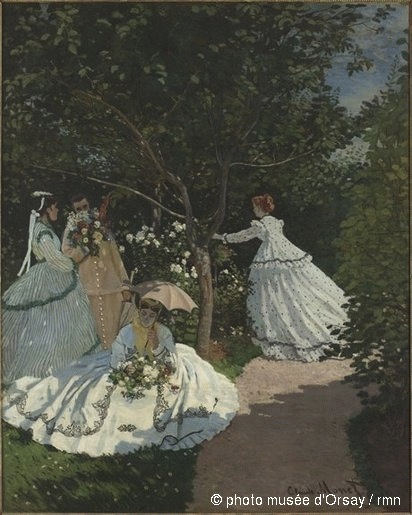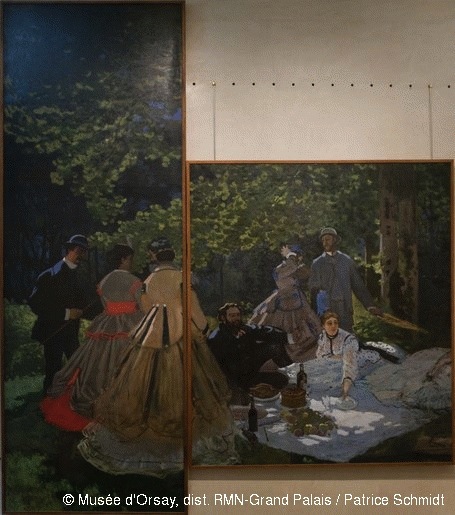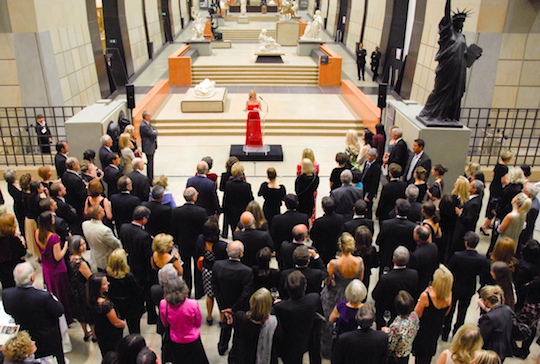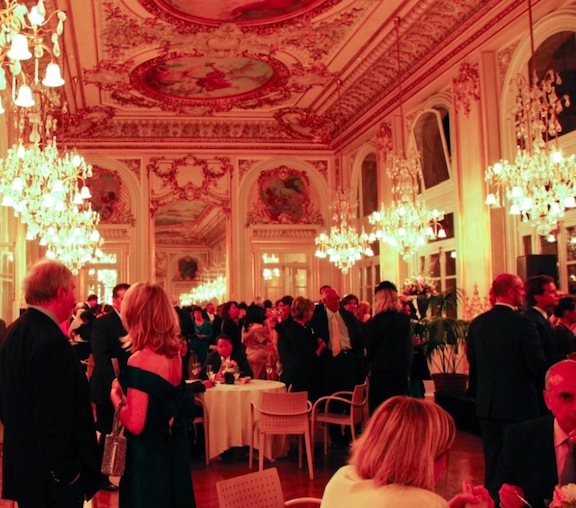
Outside it's cold, black and wet. Come inside and up the stairs! And you will see a young lady sitting on the leafy turf with a heap of flowers in her lap, holding a delicate parasol. Sunlight dapples the great bursts of leaves that flutter on the trees, and lands softly on her voluminous white dress, which cascades and cavorts across the grass.
Suddenly, a scarlet sash catches my eye. Then, I take in the cobalt blues, whites, polka dots, the fashionable bonnets and top hats. I walk a circle around Madame Bartholomé's dress to get a better look...

I had been fortunate enough to be invited by The American Friends of the Musée D'Orsay (AFMO)(board members include Peter and Susan Solomon, Susan Tolson and Alice Tisch, among others) to a private cocktail reception and preview of the Impressionism, Fashion and Modernity exhibition at Metropolitan Museum a week before the show opened to the public.
To roam the Tisch galleries' six magnificent rooms by night, adorned with the best of Monet, Tissot, Renoir, Morisot, Courbet -- some of my favorite artworks in the world -- and with the curators of the show, Guy Cogeval, President of the Musée D'Orsay, Susan Alyson Stein of the Met, and Gloria Groom of the Art Institute of Chicago, within an arm's reach -- what a treat! The exhibit (a blockbuster hit in Paris last September through January, and heading to the Art Institute of Chicago in June) is wonderfully uplifting.
Beautiful and seductive, comprehensive and fascinating, but apparently not as magical as the Orsay version in Paris. Cogeval explained to me that, partly due to the more intimate size and layout of the rooms in the Orsay, the home exhibit took on a more 'fanciful' feel. "It was full of surprises!" Cogeval declared.
At the Metropolitan Museum, the didactic element of the show resonates forcefully, encouraging a more thorough assimilation of the issues and idiosyncrasies of the Impressionist era and its relation to the increasingly important role of fashion in Paris at that time.
Then with a sudden flurry of passion restrained at the last moment as if to say "but this is so obvious", Monsieur Cogeval threw his hands into the air, gestured around the glorious room and cried "But what more could you want! You have [Monet's] Luncheon On The Grass in the entrance...!"

How was it that one of these coveted paperless post invites landed in my Inbox? I had met Verena Thornton, before she was appointed as Executive Director of AFMO, in Paris a couple of years back. I had an eagerness to find out more about the organization, and, in turn, she was eager to accommodate my interest.
AFMO's mission is to raise awareness and financial support for the 'revitalized' Musée D'Orsay, and its sister institution, the Musée de l'Orangerie. The Musée D'Orsay is the world's largest and finest repository of Impressionist art (it is home to around 34 Manets, 86 Monets, 43 by Degas, 81 Renoirs, among many others) and pulled in 3.6 million visitors last year (approximately 15 percent of those were Americans).
 Photo credit: AFMO/Anastasia Nielson
Photo credit: AFMO/Anastasia Nielson
Impressionism, Fashion and Modernity, which took five years' work to prepare, was conceived through a collaboration between Gloria Groom in the U.S. and Guy Cogeval in Paris.
AFMO are keen to attract Americans who recognize that "Thinking beyond national borders benefits everyone, from the curators who learn from each other, to the museums which present their collections in new exciting ways, and the international public who gains new insight and understanding..."
Since it was founded in 2009, it appears that the organization has won significant financial support for the museum from several large American corporate donors, sponsors and charity foundations.
A major part of Thornton's role is to grow their number of supporting individual donors, namely AFMO members. The annual membership ranges in rank from $200 to $20,000, and the list of membership benefits varies accordingly. You need to be at least of 'Benefactor' rank paying $5,000 to receive invitations to private events.
My immediate thought was: How does Thornton expect Americans to give money to a French museum? American museums need money! What is the real pull factor which makes Americans sign up?
Could it be the long-standing American love affair with Paris?
It's been expressed many times over in American literature, art and film. From Thomas Appleton's oft-quoted witticism "Good Americans when they die, go to Paris," in David McCullough's recent book The Greater Journey: Americans in Paris, to Woody Allen's 2011 film Midnight In Paris:
That Paris exists and anyone could choose to live anywhere else in the world will always be a mystery to me [...] these lights, I mean come on, there's nothing happening on Jupiter or Neptune, but from way out in space you can see these lights, the cafés, people drinking and singing. For all we know, Paris is the hottest spot in the universe.
According to Thornton, about 40 percent of her current AFMO members reside in the 'city of lights,' and many of the ones that don't, own an apartment there, as a second home. So the idea of being part of a like-minded community of Francophiles, contributing to the preservation and enrichment of their favorite city's unique cultural heritage -- not to mention, being invited to the exclusive events and glamorous dinners -- is an attractive one.
 Photo credit: AFMO/Anastasia Nielson
Photo credit: AFMO/Anastasia Nielson
Verena Thornton organized the dinner for the Impressionism and Fashion gala in the beautiful Orangerie museum last Fall.
What's also attractive, of course, are the tax breaks. Individual donors can get an income tax break of 66 percent, and corporations, 60 percent.
According to Thornton, most of AFMO's members also support local or U.S. art institutions. Indeed, over here, philanthropy is the number one revenue source for the arts. France and the UK are used to the opposite model, with their respective Ministry of Culture providing the bulk of the revenue.
But France's financial crisis, and its new Left government has meant a 4.3 percent drop for the cultural budget, with a 9.8 percent drop in the heritage field. Rather than approach millionaires, appealing to the masses is now the prominent strategy for saving their 'self-stated reputation as the cultural powerhouse of Europe.' In recent months, directors of the major cultural institutes have incited a flock of crowd-funding petitions (a move which coincidentally falls in line with the government's plan to democratize culture throughout the country).
Meanwhile, a third of French patrons are now saying they plan to reduce or completely stop giving donations to the Arts, despite culture being one of the only departments that have been allowed to keep its tax exemptions.
Without support from national and international non-profits such as AFMO, and given Monsieur Hollande's wish to put an end to grand Parisian cultural projects, France's splendid art institutions could easily flounder and become rather isolated. Sharing cultural heritage across borders, which is exemplified so brilliantly in Impressionism, Fashion and Modernity brings joy and insight to so many people; it would be a 'grand dommage' to lose it.